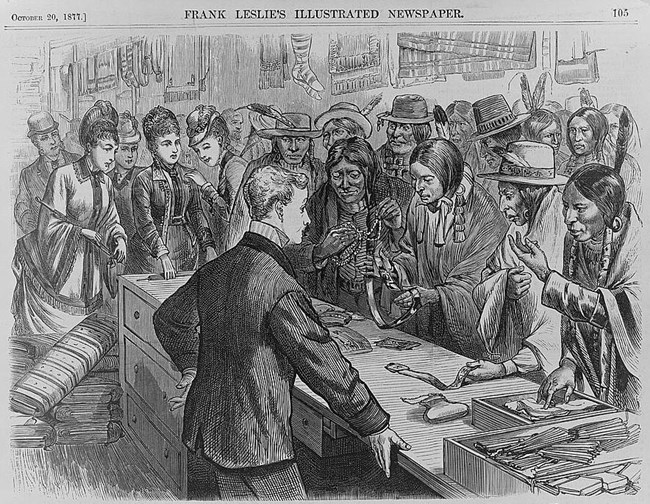Part of a series of articles titled Selections from Historic Contact: Early Relations Between Indian People and Colonists in Northeastern North America, 1524-1783.
Article
Historic Contact in the Northeast: Part I

Collections of the Library of Congress. https://www.loc.gov/item/2002695160/
Selections from the National Historic Landmark Theme Study
By: Robert S. Grumet, National Park Service, 1992
Historic Contact in the Northeast Part I
People, it seems, have always been fascinated by contact. The very idea of it conjures up images of exotic places, curious customs, and historic events. Perhaps the source of this fascination lies in the fact that, at its most basic level, contact is the story of encounters between strangers. Everyone knows about strangers. … Allies or adversaries, they provide otherwise unobtainable goods and services. Basic human institutions such as trade, diplomacy, marriage, and war all trace their origins to the common human need to deal with such people….No matter how much we come to depend upon strangers or how familiar they become, we can never entirely be sure that they think about or feel things in quite the same ways we do. Recognizing the fact that no two people perfectly understand one another, anthropologist Marshall Sahlins has used the expression “creative misunderstanding” to characterize relationship between strangers meeting each other’s expectations for often entirely different reasons.
Whether contacts occur in face-to-face meetings or as indirect transactions knowingly or unknowingly brokered by intermediaries, all encounters between strangers move ideas, people, and things across cultural divides. Words usually used to characterize such movements, like trade, exchange, or war, and imprecise approximations rarely conveying their full meanings or implications. Coercive or compulsory exchanges, for example, may more closely resemble war or taxation than trade. Locations, compositions, and boundaries of groups involved in exchanges, moreover, frequently can change. All of these factors further rarely are seen the same way by different people. Because of these facts, the consequences of contact are neither predictable nor controllable. Under certain conditions, introduced ideas, materials, or technologies may revolutionize societies and overturn established orders. Under others, contact seems to merely reaffirm people’s most cherished notions of themselves and their place in the world. No matter what their causes or consequences, people everywhere struggle to reap what they regard as the benefits of contact while avoiding what they feel are its hazards or drawbacks.
The story of historic contact between Indians and colonists in Northeastern North America has its own inherent fascination. As geographer David Lowenthal reminds us, other times fascinate as much as other people and places. Fewer regions of the world have seen greater numbers of strangers in contact with each other in more places at one time than in Northeastern North America between 1524 and 1783. Small wonder, then, that people…been fascinated by stories of contact in the Northeast since world of the first European voyages to places like Canada, New England, and Virginia spread throughout the Eastern and Western hemispheres.
Last updated: May 16, 2019
